The Rise and Fall of the British Textile Industry, What is an ASBO?, The Climate Changers – IELTS Reading Answers
19 min read
Updated On
-
Copy link
Table of Contents

Limited-Time Offer : Access a FREE 10-Day IELTS Study Plan!
In the Academic Reading practice test, “The Rise and Fall of the British Textile Industry, What is an ASBO?, and The Climate Changers” there are 40 questions of various question types. We at IELTSMaterial.com would urge every IELTS aspirant to time this test as in the real exam and find the answers without looking at the key. If you have scored 40/40, then we wish you all the best. If you haven’t, then we would earnestly advise you to take one of our IELTS reading practice tests.
Here are question types in this reading test
Reading Passage 1 (The Rise and Fall of the British Textile Industry)
- Note completion
- Multiple Choice Questions
- True or False / Not Given
Reading Passage 2 (What is an ASBO?)
- Multiple Choice Questions
- Sentence completion
Reading Passage 3 (The Climate Changers)
- Multiple Choice Questions
- Summary completion
- True or False / Not Given
Reading Passage 1
The Rise and Fall of the British Textile Industry
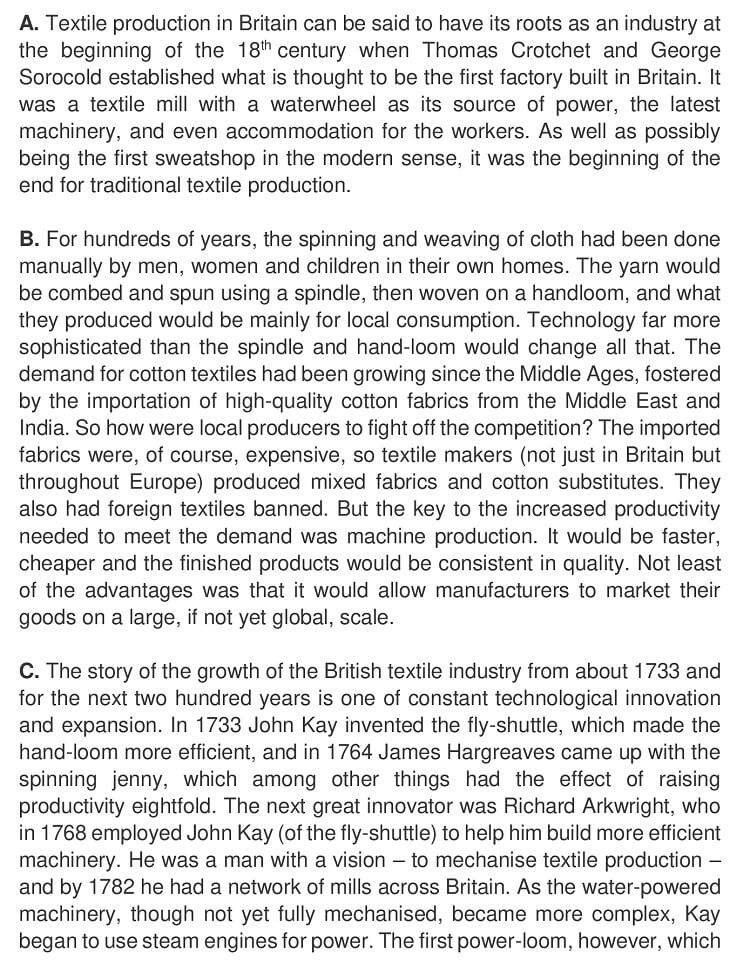
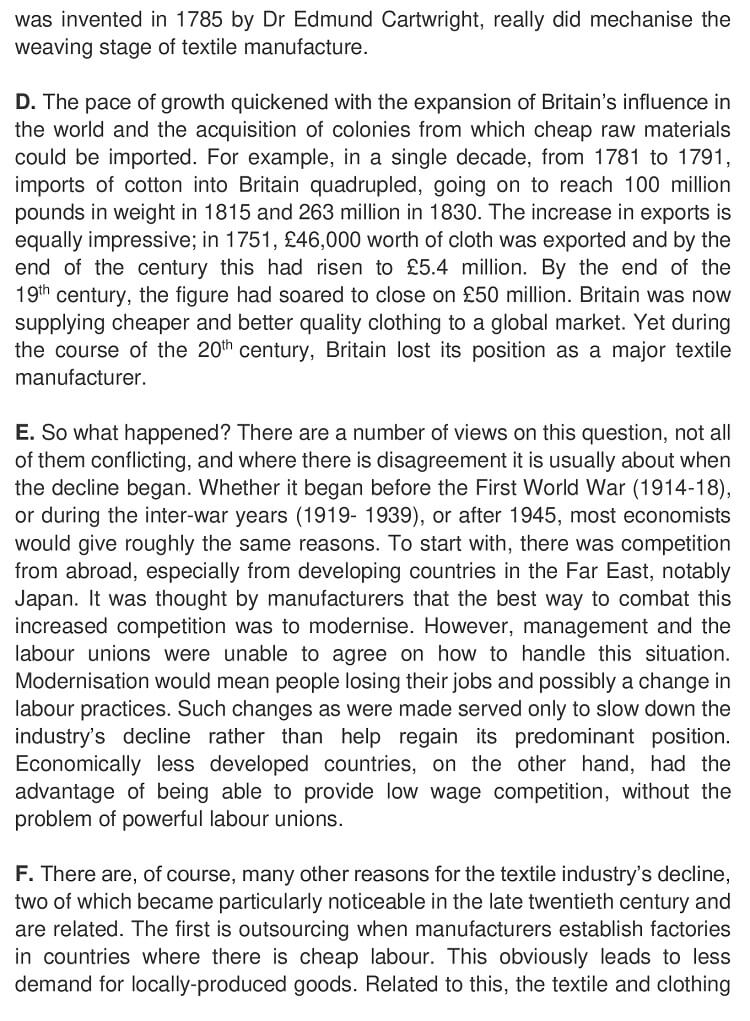
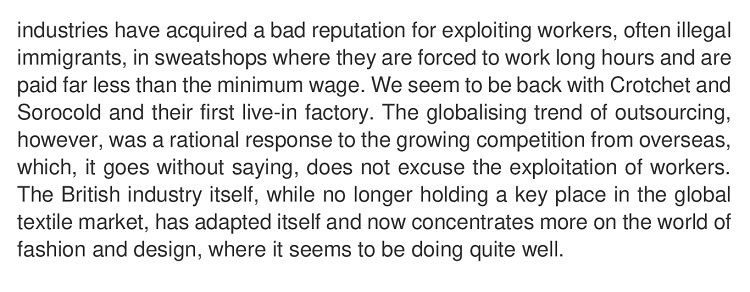
[do_widget id=custom_html-47]
Questions 1-6
Complete the notes below.
Write NO MORE THAN THREE WORDS for each answer.
Textile Manufacture
Early history
Begins as a cottage industry
Products hand-woven and made for 1……………………………………………
Local producers face 2…………………………………………………… from overseas
Ways found to deal with the situation
Imported fabrics 3………………………………………………………, mixed cotton produced
Early technology
Machine production needed to 4…………………………………………………… for cotton fabrics
Improved technology (such as the fly-shuttle) more 5……………………………………. and productive
Machinery begins to be powered by 6……………………………………………………..
Questions 7-9
7 Which of the following innovations increased productivity by 800%?
A the power-loom
B the steam engine
C the spinning jenny
D the fly-shuttle
8 During which period was the British textile industry at its peak?
A 733-1785
B 1781-1791
C 1791-1830
D 1830-1900
9 Which of the following was a major cause of the British textile industry’s decline?
A the expansion of foreign textile industries
B the loss of overseas markets
C there is no demand for products
D labour becoming too expensive
Questions 10-13
Do the following statements agree with the information given in Reading Passage 1?
TRUE, if the statement agrees with the information
FALSE, if the statement contradicts the information
NOT GIVEN, if there is no information on this
10 Foreign textiles were banned because of their inferior quality.
11 Richard Arkwright built the first fully mechanised textile mill.
12 In less developed countries, the industry could rely on cheap labour.
13 Out-sourcing was one method used to compete with foreign manufacturers.
Also check:
- IELTS Reading
- Tips to Improve IELTS Reading Skills
- True False Not Given IELTS Reading
- IELTS Reading recent actual test
- IELTS Academic Reading test papers with answers pdf
Reading Passage 2
What is an ASBO?
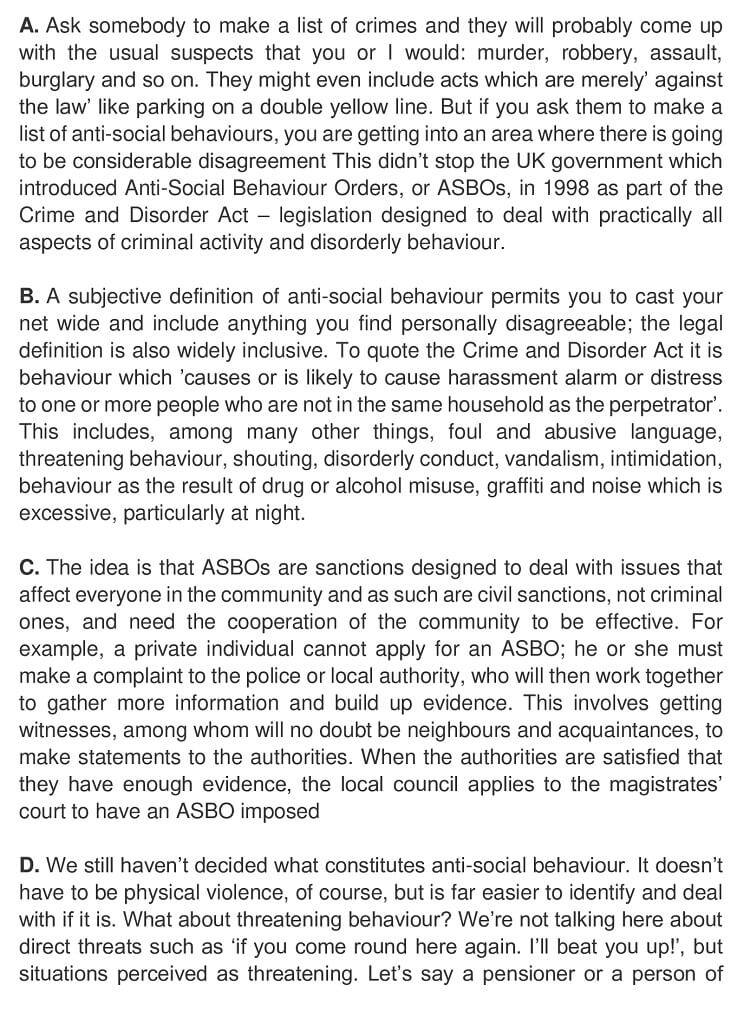
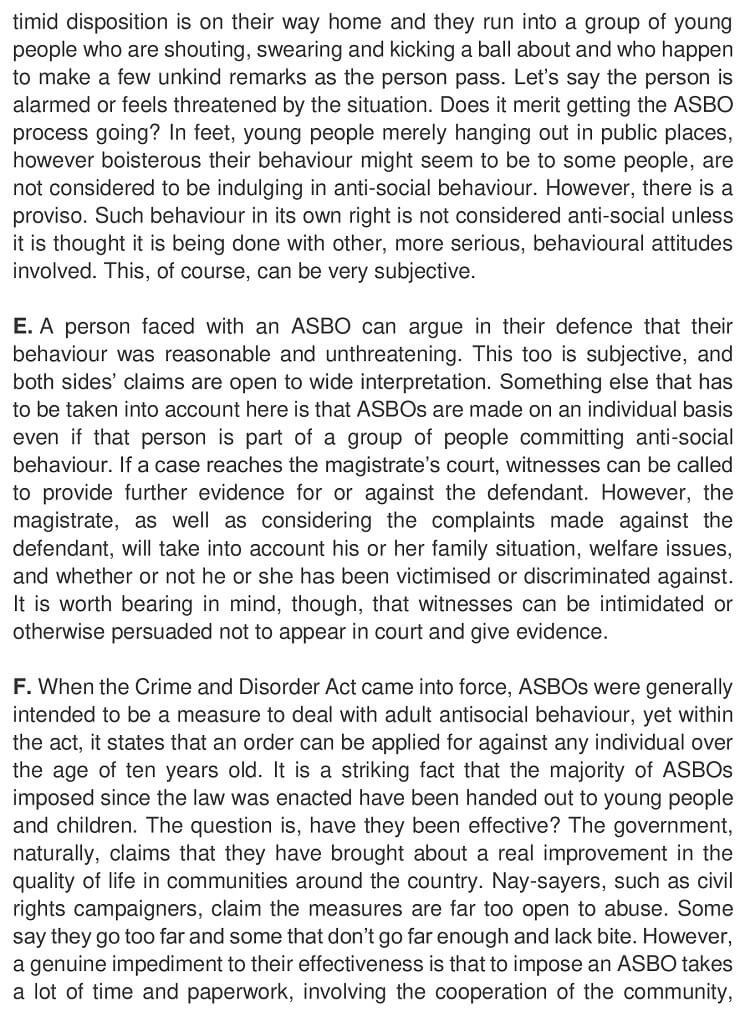

Question 14-16
Choose THREE letters A-H.
NB, Your answers may be given in any order.
Which THREE of the following statements are true of ASBOs, according to the text?
A They were introduced to deal with specific crimes.
B Parking on a double yellow line could get you served with an ASBO.
C Swearing is one of the offences referred to in the Crime and Disorder Act.
D Asa private householder you can apply for an ASBO against a noisy neighbour.
E It is not illegal for young people to gather in groups in public places.
F An ASBO cannot be served on a group of people behaving in a disorderly manner.
G A large proportion of those served with ASBOs are over the age of 21.
H Most people agree that ASBOs have been effective all over the country.
14
15
16
Questions 17-19
17 The writer suggests that
A anti-social behaviour should be seen as a crime.
B few people agree on how to define a crime.
C anti-social behaviour is difficult to define.
D the legal definition of crime is too exclusive.
18 What surprised the writer about the imposition of ASBOs?
A the number of ten-year-olds that had been given one.
B that very few adults had been served with ASBOs.
C that most of those served with ASBOs were youngsters.
D how few ASBOs had been imposed since 1998.
19 In the writer’s opinion, how effective have ASBOs been?
A There isn’t enough evidence to decide.
B They are too expensive to be effective.
C They are ineffective because they are not strict enough.
D Being open to abuse renders them ineffective.
Question 20-26
Complete the sentences.
Choose NO MORE THAN THREE WORDS from the passage for each answer.
20 The official_____________________________ says that anti-social behaviour is behaviour which can cause alarm or distress.
21 Along with swearing and destruction of public or private property, making ____________ noise is considered anti-social behaviour.
22 ASBOs are considered to be part of _______________________ law rather than criminal law.
23 Citizens have to____________________________ to either the local council or the police before any action can be taken.
24 In their efforts to collect evidence the authorities may call on ________________ to get more information.
25 ASBOs are issued at a_____________________________ .
26 ___________________________ is the most straightforward form of anti-social behaviour to determine.
Reading Passage 3
The Climate Changers
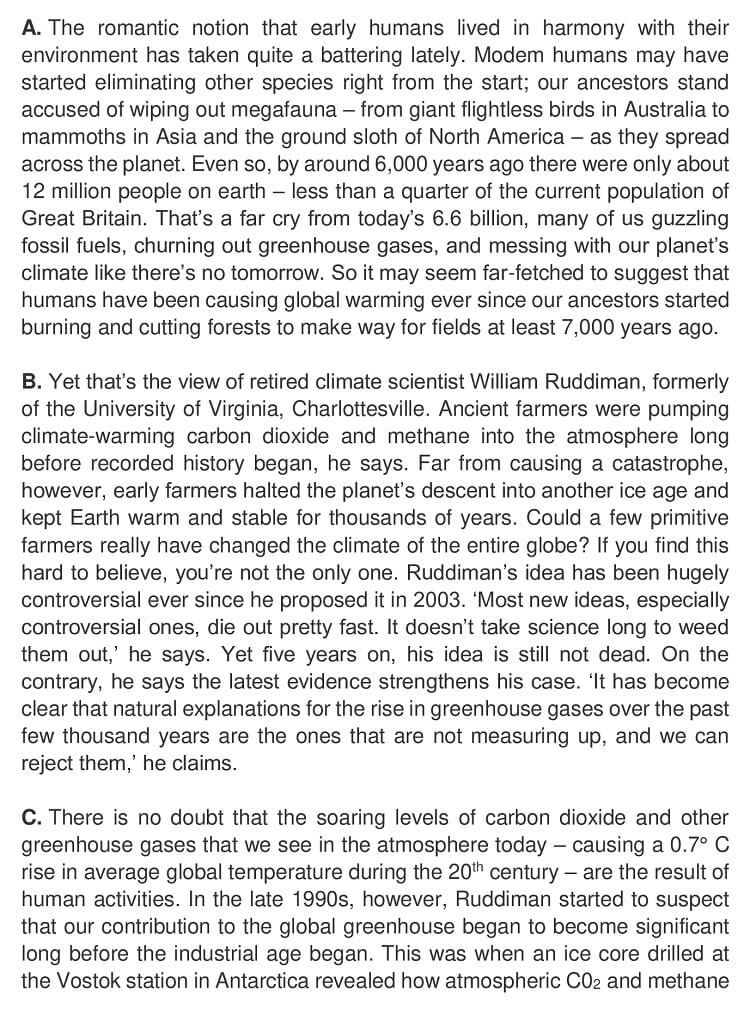


Questions 27-29
27 One of the claims Ruddiman makes is that
A population growth is responsible for global warming.
B people have affected the climate for thousands of years.
C his ideas are not in the least bit controversial.
D so far scientists have been wrong about global warming.
28 What information did the research at Vostok reveal for the first time?
A that methane levels stabilized about 11,000 years ago
B that Antarctic ice contains methane bubbles
C that the methane levels increased about 5,000 years ago
D that we are now living in a warm interglacial period
29 The climate changers’ of the title are
A modem humans.
B climate modellers.
C primitive farmers.
D natural causes.
Questions 30-34
Complete the summary.
Choose NO MORE THAN TWO WORDS from the passage for each answer.
To many people the controversial idea that our 30_____________ were responsible for global warming appears 31____________ . Yet Ruddiman believes that high levels of carbon dioxide and methane – both 32_____________ , or greenhouse, gases – were being released into the Earth’s atmosphere in times prior to 33_____________ . However, Ruddiman claims that this had a positive effect, as it may well have saved us from another 34____________ .
Questions 35-40
Do the following statements agree with the information given in Reading Passage 3?
TRUE, if the statement agrees with the information
FALSE, if the statement contradicts the information
NOT GIVEN, if there is no information on this
35 Some megafauna has been eliminated by humans in the past 100 years.
36 Agriculture is considered a primary cause of global warming today.
37 Ruddiman’s idea caused a great deal of argument among scientists.
38 New scientific evidence proves for certain that Ruddiman’s theory is correct.
39 The 20th century has seen the greatest ever increase in global temperatures.
40 Changes in the Earth’s orbit can affect global temperatures.
Answers
Unlock Answer
Signup/Login and get access to the answers
The Rise and Fall of the British Textile Industry Reading Answers (Passage 1)
1 Answer: local consumption
Question Type: Note Completion
Answer location: Paragraph B, line 2
Answer explanation: The answer is clearly mentioned in the said paragraph and line. In the passage, it is said that “the yarn would be combed and spun using a spindle, then woven on a hand loom, and what they produced would be mainly for local consumption.” From the given information we can deduce that the term woven on a hand loom has been paraphrased to products hand-woven and “made” can be paraphrased to “produced”. Hence in early cottage industry products were made (produced) mainly for local consumption.
2 Answer: competition
Question Type: Note Completion
Answer location: Paragraph E, line 4
Answer explanation: In the reference paragraph, the author mentions that “to start with, there was competition from abroad, especially from developing countries in the Far East, notably Japan.” Here, we can observe that the problem local producers faced and had to deal with is competition from the Far east and Japan.
3 Answer: banned
Question Type: Note Completion
Answer location: Paragraph B, line 7
Answer explanation: Few lines in the said paragraph discuss that “they also had foreign textiles banned.” Here, we can infer that the term foreign has been paraphrased to imported. So, we can state that foreign (imported) textiles are banned.
4 Answer: meet (the) demand
Question Type: Note Completion
Answer location: Paragraph B, line 8
Answer explanation: In the said paragraph, you can find out that “but the key to the increased productivity needed to meet the demand, was machine production.” This line confirms that machine production is needed to meet the demand for cotton fabric.
5 Answer: efficient
Question Type: Note Completion
Answer location: Paragraph C, line 2
Answer explanation: If you read thoroughly, a line in the passage specifies that “in 1733 John Kay invented the fly-shuttle, which made the hand-loom more efficient, and in 1764 James Hargreaves came up with the spinning jenny, which among other things had the effect of raising productivity eightfold.” Here, we can infer that fly-shuttle helped hand-loom to become more efficient and spinny Jeny raised its productivity.
6 Answer: steam (engines)
Question Type: Note Completion
Answer location: Paragraph C, 2nd last line
Answer explanation: If you observe, in the said paragraph to the fact that “as the water-powered machinery, though not yet fully mechanised, became more complex, Kay began to use steam engines for power.” From the given information we can conclude that steam engines grew popular as water-powered technology got increasingly complicated.
7 Answer: C
Question Type: Multiple Choice Question
Answer location: Paragraph C, line 2
Answer explanation: In the said paragraph, refer that, “in 1733 John Kay invented the fly-shuttle, which made the hand-loom more efficient, and in 1764 James Hargreaves came up with the spinning jenny, which among other things had the effect of raising productivity eightfold.” Here, the term eightfold means eight times as great or as numerous. So, it implies that spinning jenny innovation increased productivity by eightfold (800%).
8 Answer: D
Question Type: Multiple Choice Question
Answer location: Paragraph D, line 4
Answer explanation: The answer is clearly mentioned in the said paragraph and line. In the passage, it is said that “by the end of the 19th century the figure had soared to close on £50 million.” Since it is mentioned that at the end of 19th-century imports and exports figures sored to around £50 million, which mean the highest figures in between 1830 – 1900.
9 Answer: A
Question Type: Multiple Choice Question
Answer location: Paragraph D, line 1
Answer explanation: The opening line of paragraph D puts forward the information that “the pace of growth quickened with the expansion of Britain’s influence in the world and the acquisition of colonies from which cheap raw materials could be imported.” Also, “to start with, there was competition from abroad, especially from developing countries in the Far East, notably Japan.” So, the major cause of the decline of the British textile industry is because there was competition from abroad (countries such as Japan).
10 Answer: FALSE
Question Type: True/False/Not Given Questions
Answer location: Paragraph B, line 4
Answer explanation: In the reference paragraph, the author mentions that “The demand for cotton textiles had been growing since the Middle Ages, fostered by the importation of high-quality cotton fabrics from the Middle East and India. So how were local producers fight off the competition? The imported fabrics were of course expensive, so textile makers (not just in Britain but throughout Europe) produced mixed fabrics and cotton substitutes. They also had foreign textiles banned.” In the given lines it is mentioned that foreign textiles were banned because of competition, and not inferior quality. Hence, the information given in the passage contradicts the question.
11 Answer: NOT GIVEN
Question Type: True/False/Not Given Questions
Answer location: N/A
Answer explanation: None of the passages confirms or denies that Richard Arkwright built the first fully mechanised textile mill.
12 Answer: TRUE
Question Type: True/False/Not Given Questions
Answer location: Paragraph E, last line
Answer explanation: In the said paragraph, you can find out that “economically less developed countries, on the other hand, had the advantage of being able to provide low wage competition, without the problem of powerful labour unions.” This statement confirms that economically less developed countries had the advantage of being able to provide cheap labour (low wage competition).
13 Answer: TRUE
Question Type: True/False/Not Given Questions
Answer location: Paragraph F, line 5
Answer explanation: If you read thoroughly, a line in the said paragraph discusses that “the globalising trend of out-sourcing, however, was a rational response to the growing competition from overseas, which, it goes without saying, does not excuse the exploitation of workers.” Here, the rational response has been paraphrased to the method, and competition from overseas has been paraphrased to compete with foreign manufacturers. Thus, it is true that out-sourcing was one method used to compete with foreign manufacturers.
What is an ASBO? Reading Answers (Passage 2)
14 Answer: C (C, E, F :in any order)
Question Type: Multiple Choice Questions
Answer location: Paragraph B, line 3
Answer explanation: A line in the said paragraph states that “this includes, among many other things, foul and abusive language, threatening behaviour, shouting, disorderly conduct, vandalism, intimidation, behaviour as the result of drug or alcohol misuse, graffiti, and noise which is excessive, particularly at night.” Here, the terms foul and abusive language confirm that profanity is a socially offensive use of language, which may also be called cursing, swearing, or expletives. Hence, swearing is one of the offenses referred to in the Crime and Disorder Act.
15 Answer: E (C, E, F :in any order)
Question Type: Multiple Choice Questions
Answer location: Paragraph D, line 9
Answer explanation: If you read thoroughly, a line in the said paragraph discusses that “in fact, young people merely hanging out in public places, however boisterous their behaviour might seem to be to some people, are not considered to be indulging in anti-social behaviour.” Here, young people merely hanging out in public places can inferred as young people to gather in groups in public places. Also, since it is stated it is not considered anti-social behavior, we can conclude that it is not illegal for young people to gather in groups in public places.
16 Answer: F (C, E, F :in any order)
Question Type: Multiple Choice Questions
Answer location: Paragraph E, line 3
Answer explanation: A line in the said paragraph states that “something else that has to be taken into account here is that ASBOs are made on an individual basis even if that person is part of a group of people committing anti-social behaviour.” Since it is given that ASBOs are made on an individual basis we can deduce that ASBO cannot be served on a group of people behaving in a disorderly manner.
17 Answer: C
Question Type: Multiple Choice Questions
Answer location: Paragraph A, line 3
Answer explanation: A line in the given paragraph suggests that “but if you ask them to make a list of anti-social behaviours, you are getting into an area where there is going to be considerable disagreement.” Here, the author suggests that it is difficult to list down the anti-social behaviour pattern.
18 Answer: C
Question Type: Multiple Choice Questions
Answer location: Paragraph F, line 2
Answer explanation: In the reference paragraph, the author mentions that “it is a striking fact that the majority of ASBOs imposed since the law was enacted have been handed out to young people and children.” Here, striking fact denotes a surprise and “handed out” can be understood as “served”. Thus, it suggests that the author was surprised to find out that most of the ASBOs were youngsters.
19 Answer: A
Question Type: Multiple Choice Questions
Answer location: Paragraph F, last line
Answer explanation: In the said paragraph, you can find out that “what all this means is that ASBOs are being used very rarely in many parts of the country. So the jury is still out as to how effective they really are” Since author states that the jury is still out as to how effective is ASBO is, it implies that there isn’t enough evidence to decide.
20 Answer: definition
Question Type: Sentence Completion
Answer location: Paragraph B, line 1
Answer explanation: The opening line of paragraph B suggests that “a subjective definition of anti-social behaviour permits you to cast your net wide and include anything you find personally disagreeable; the legal definition is also widely inclusive.” The term legal definition can also be understood as an official definition, as legal also means official.
21 Answer: excessive
Question Type: Sentence Completion
Answer location: Paragraph B, last line
Answer explanation: The answer is clearly mentioned in the said paragraph and line. You must note the paraphrasing here. In the passage, it is said that “this includes, among many other things, foul and abusive language, threatening behaviour, shouting, disorderly conduct, vandalism, intimidation, behaviour as the result of drug or alcohol misuse, graffiti and noise which is excessive, particularly at night.” Swearing is often considered foul language. Hence, swearing and destruction of public or private property (vandalism), making noise that is excessive are considered anti-social.
22 Answer: civil
Question Type: Sentence Completion
Answer location: Paragraph C, line 1
Answer explanation: In the reference paragraph, the author mentions that “The idea is that ASBOs are sanctions designed to deal with issues that affect everyone in the community and as such are civil sanctions, not criminal ones, and need the cooperation of the community to be effective.” As it is given that ASBO is designed to deal with issues that affect the community and as such are civil sanctions, we can infer that ASBO is part of civil law.
23 Answer: make a complaint
Question Type: Sentence Completion
Answer location: Paragraph C, line 2
Answer explanation: According to passage C “a private individual cannot apply for an ASBO; he or she must make a complaint to the police or local authority, who will then work together to gather more information and build up evidence.“ The author states that ASBO cannot be applied by individual people, if they wish it to be applied then they have to make a complaint to their police or local council.
24 Answer: witnesses/neighbours/acquaintances
Question Type: Sentence Completion
Answer location: Paragraph C, line 3
Answer explanation: If you read thoroughly, a line in the said paragraph discusses that “this involves getting witnesses, among whom will no doubt be neighbors and acquaintances, to make statements to the authorities.” Also, if anyone wishes ASBO to be applied to individual people they have to collect evidence (make statements) of witnesses (neighbours/acquaintances).
25 Answer: magistrates’ court
Question Type: Sentence Completion
Answer location: Paragraph C, line 4
Answer explanation: The answer is clearly mentioned in the said paragraph and line. You must note the paraphrasing here. In the passage, it is said that “when the authorities are satisfied that they have enough evidence, the local council applies to the magistrates’ court to have an ASBO imposed.” Since local councils and police rely on magistrates’ courts to impose ASBOs, it implies magistrates’ court issues ASBOs.
26 Answer: Physical violence
Question Type: Sentence Completion
Answer location: Paragraph D, line 2
Answer explanation: The answer is clearly mentioned in the said paragraph and line “we still haven’t decided what constitutes anti-social behaviour. It doesn’t have to be physical violence, of course, but is far easier to identify and deal with if it is.” Here, the author states that physical violence is the most straightforward form of anti social behaviour to determine.
The Climate Changers Reading Answers (Passage 3)
Question Type: Multiple Choice Questions
Answer location: Paragraph A, last line
Answer explanation: The entire sentence has been paraphrased here. In the passage, it states that “so it may seem far-fetched to suggest that humans have been causing global warming ever since our ancestors started burning and cutting forests to make way for fields at least 7,000 years ago.” 7,000 years ago can also be inferred as thousands of years. Hence, according to Ruddiman, our ancestors (people) have affected the climate (by burning and cutting forests) for thousands of years (7,000 years).
28 Answer: C
Question Type: Multiple Choice Questions
Answer location: Paragraph E, line 3
Answer explanation: If you read thoroughly, there’s a line in the said paragraph that describes “but instead of continuing to fall to what Ruddiman says should have been a minimum of about 450 ppb today, the atmospheric methane began to climb again 5,000 years ago.” The atmospheric methane began to increase (climb again) about 5,000 years ago.
29 Answer: C
Question Type: Multiple Choice Questions
Answer location: Paragraph B, line 4
Answer explanation: Paragraph A provides the information that “Could a few primitive farmers really have changed the climate of the entire globe? If you find this hard to believe, you’re not the only one.” From this line, we can confirm that author is referring to primitive farmers as climate changers and blames them for being responsible for climate change.
30 Answer: ancestors
Question Type: Summary Completion
Answer location: Paragraph A, last line
Answer explanation: A line in the paragraph denotes “so it may seem far-fetched to suggest that humans have been causing global warming ever since our ancestors started burning and cutting forests to make way for fields at least 7,000 years ago.” The idea that our ancestors caused global warming may be unconvincing to many people.
31 Answer: far-fetched
Question Type: Summary Completion
Answer location: Paragraph A, last line
Answer explanation: Few lines in the said paragraph convey that “so it may seem far-fetched to suggest that humans have been causing global warming ever since our ancestors started burning and cutting forests to make way for fields at least 7,000 years ago.” Thus, apart from saying ancestors were responsible for global warming the author also mentions that this idea may seem (appear) far-fetched (unconvincing) to some.
32 Answer: climate-warming
Question Type: Summary Completion
Answer location: Paragraph B, line 2
Answer explanation: If you read thoroughly, there’s a line that claims “ancient farmers were pumping climate-warming carbon dioxide and methane into the atmosphere long before recorded history began, he says.” Ruddiman believes that climate-warming gases like carbon dioxide and methane were released into the atmosphere by ancient farmers.
33 Answer: recorded history
Question Type: Summary Completion
Answer location: Paragraph B, line 2
Answer explanation: If you read thoroughly, there’s a line that claims “ancient farmers were pumping climate-warming carbon dioxide and methane into the atmosphere long before recorded history began, he says.” Ruddiman also believes that ancient farmers were releasing these gases into the atmosphere long before recorded history began.
34 Answer: ice age
Question Type: Summary Completion
Answer location: Paragraph E, line 5
Answer explanation: A line in the said paragraph indicates “Ruddiman has shown that if the levels of these gases had continued to fall rather than rising when they did, ice sheets would now cover swathes of northern Canada and Siberia. The world would be heading into another ice age.” From this information, we can confirm that Ruddiman has shown that if these harmful gases fell ice sheets would now cover swathes of northern Canada and Siberia. This can also be understood in other words, as it mentions that Ruddiman claims that this had a positive effect, as it may well have saved us from another ice age.
35 Answer: FALSE
Question Type: True/False/Not Given Question
Answer location: Paragraph A, line 3
Answer explanation: In the said paragraph, you can point out that “modem humans may have started eliminating other species right from the start; our ancestors stand accused of wiping out megafauna – from giant flightless birds in Australia to mammoths in Asia and the ground sloth of North America – as they spread across the planet.” Since the author states old ancestors are responsible for wiping (eliminating) megafauna, this proves that humans in the past 100 years are not the only ones responsible for it.
36 Answer: NOT GIVEN
Question Type: True/False/Not Given Question
Answer location: N/A
Answer explanation: None of the passages confirms or denies that agriculture is considered a primary cause of global warming today.
37 Answer: TRUE
Question Type: True/False/Not Given Question
Answer location: Paragraph B, line 6
Answer explanation: If you read clearly there is a line in the passage that claims “Ruddiman’s idea has been hugely controversial ever since he proposed it in 2003.” Since controversy means heated discussion, we can deduce that Ruddiman’s idea caused a great deal of argument among scientists.
38 Answer: FALSE
Question Type: True/False/Not Given Question
Answer location: Paragraph B, line 9
Answer explanation: Few lines in the said paragraph convey that “yet five years on, his idea is still not dead. On the contrary, he says the latest evidence strengthens his case not proves it correct.” Here, the latest evidence just strengthens his case, it does not support it (proves), which means his theory was not correct.
39 Answer: NOT GIVEN
Question Type: True/False/Not Given Question
Answer location: N/A
Answer explanation: None of the passages confirms or denies that the 20th century has seen the greatest ever increase in global temperatures.
40 Answer: TRUE
Question Type: True/False/Not Given Question
Answer location: Paragraph D, line 2
Answer explanation: The author in the given passage puts forward the information that “there are good explanations for these cycles: periodic changes in the planet’s orbit and axis of rotation alter the amount of sunlight reaching the Earth.” Since changes in the earth’s orbit and axis can change the amount of sunlight reaching on it’s surface, we can infer author is suggesting that changes in the Earth’s orbit can affect global temperatures
Practice IELTS Reading based on question types

Start Preparing for IELTS: Get Your 10-Day Study Plan Today!
Explore other Reading Practice Tests

Kasturika Samanta

Kasturika Samanta

Nehasri Ravishenbagam
Recent Articles

Nehasri Ravishenbagam

Haniya Yashfeen

Haniya Yashfeen

Haniya Yashfeen




Post your Comments
1 Comment